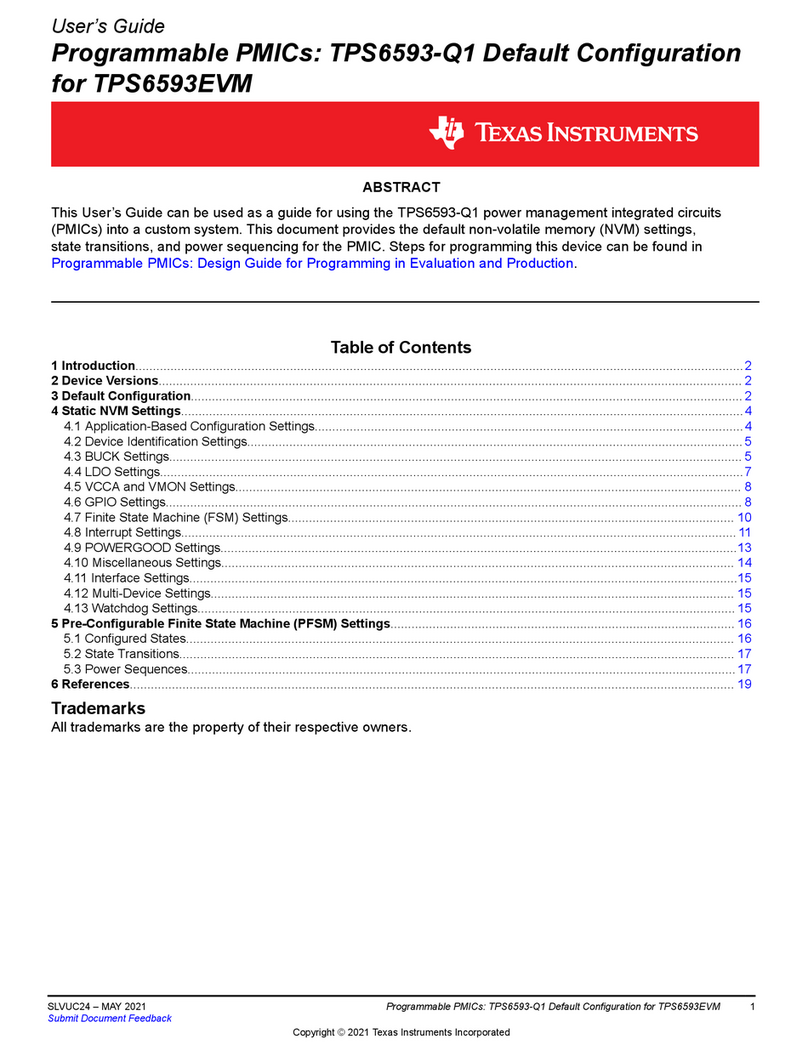
Note
SYNCA, SYNCB, and SYNCC SMAs are used to provide external SYNC signals from the FPGA. The
cables of each SYNC signal have equal length to verify the signal arrives at the same time for all
boards using these SYNCs. The TRIG IN A/B SMA connectors can be used to trigger the FPGA from
an external source. All five SMAs can use either 3.3V or 1.8V logic CMOS signals. By default, the
EVM is setup for 3.3V logic levels. The EVM has on-board translators to set these inputs/outputs to
the correct voltage levels for the FPGA.
3.3.3.2 FPGA Mezzanine Card (FMC+) Connector
The TSW14J59 EVM has one connector to allow for the direct plug in of TI JESD204C_B serial interface
ADC and DAC EVMs. The specifications for this connector are mostly derived from the ANSI/VITA 57.4 FPGA
Mezzanine Card (FMC+) Standard. This standard describes the compliance requirements for a low-overhead
protocol bridge between the IO of a mezzanine card and an FPGA processing device on a carrier card. This
specification is being used by FPGA vendors on their development platforms.
The FMC+ connector, J3, provides the interface between the TSW14J59EVM and the ADC or DAC EVM under
test. This 560-pin Samtec high-speed, high-density connector (part number ASP-184329-01) is an excellent
choice for high-speed differential pairs up to 32.5 Gbps.
In addition to the JESD204B/C standard signals, several CMOS single-ended signals and LVDS differential
signals are connected between the FMC+ and FPGA. These signals can allow the HSDC Pro GUI to control the
SPI serial programming of ADC and DAC EVMs that support this feature. The connector pinout description is
shown in Table 3-5.
Table 3-5. FMC+ Connector Description of the TSW14J59
FMC+ Signal Name FMC+ Pin Standard JESD204 Application
Mapping
Description
DP0_RX_P/N C6 and C7 Lane 0± (M → C) JESD Serial data transmitted from mezzanine and received by carrier
DP1_RX_P/N A2 and A3 Lane 1± (M → C) JESD Serial data transmitted from mezzanine and received by carrier
DP2_RX_P/N A6 and A7 Lane 2± (M → C) JESD Serial data transmitted from mezzanine and received by carrier
DP3_RX_P/N A10 and A11 Lane 3± (M → C) JESD Serial data transmitted from mezzanine and received by carrier
DP4_RX_P/N A14 and A15 Lane 4± (M → C) JESD Serial data transmitted from mezzanine and received by carrier
DP5_RX_P/N A18 and A19 Lane 5± (M → C) JESD Serial data transmitted from mezzanine and received by carrier
DP6_RX_P/N B16 and B17 Lane 6± (M → C) JESD Serial data transmitted from mezzanine and received by carrier
DP7_RX_P/N B12 and B13 Lane 7± (M → C) JESD Serial data transmitted from mezzanine and received by carrier
DP8_RX_P/N B8 and B9 Lane 8± (M → C) JESD Serial data transmitted from mezzanine and received by carrier
DP9_RX_P/N B4 and B5 Lane 9± (M → C) JESD Serial data transmitted from mezzanine and received by carrier
DP10_RX_P/N Y10 and Y11 Lane 10± (M → C) JESD Serial data transmitted from mezzanine and received by carrier
DP11_RX_P/N Z12 and Z13 Lane 11± (M → C) JESD Serial data transmitted from mezzanine and received by carrier
DP12_RX_P/N Y14 and Y15 Lane 12± (M → C) JESD Serial data transmitted from mezzanine and received by carrier
DP13_RX_P/N Z16 and Z17 Lane 13± (M → C) JESD Serial data transmitted from mezzanine and received by carrier
DP14_RX_P/N Y18 and Y19 Lane 14± (M → C) JESD Serial data transmitted from mezzanine and received by carrier
DP15_RX_P/N Y22 and Y23 Lane 15± (M → C) JESD Serial data transmitted from mezzanine and received by carrier
DP0_TX_P/N C2 and C3 Lane 0± (C → M) JESD Serial data transmitted from carrier and received by mezzanine
DP1_TX_P/N A22 and A23 Lane 1± (C → M) JESD Serial data transmitted from carrier and received by mezzanine
DP2_TX_P/N A26 and A27 Lane 2± (C → M) JESD Serial data transmitted from carrier and received by mezzanine
DP3_TX_P/N A30 and A31 Lane 3± (C → M) JESD Serial data transmitted from carrier and received by mezzanine
DP4_TX_P/N A34 and A35 Lane 4± (C → M) JESD Serial data transmitted from carrier and received by mezzanine
DP5_TX_P/N A38 and A39 Lane 5± (C → M) JESD Serial data transmitted from carrier and received by mezzanine
DP6_TX_P/N B36 and B37 Lane 6± (C → M) JESD Serial data transmitted from carrier and received by mezzanine
DP7_TX_P/N B32 and B33 Lane 7± (C → M) JESD Serial data transmitted from carrier and received by mezzanine
DP8_TX_P/N B28 and B29 Lane 8± (C → M) JESD Serial data transmitted from carrier and received by mezzanine
DP9_TX_P/N B24 and B25 Lane 9± (C → M) JESD Serial data transmitted from carrier and received by mezzanine
DP10_TX_P/N Z24 and Z25 Lane 10± (C → M) JESD Serial data transmitted from carrier and received by mezzanine
DP11_TX_P/N Y26 and Y27 Lane 11± (C → M) JESD Serial data transmitted from carrier and received by mezzanine
DP12_TX_P/N Z28 and Z29 Lane 12± (C → M) JESD Serial data transmitted from carrier and received by mezzanine
www.ti.com Hardware Configuration
SLWU095 – APRIL 2023
Submit Document Feedback
TSW14J59EVM JESD204C Data Capture and Pattern Generator Card 7
Copyright © 2023 Texas Instruments Incorporated




























